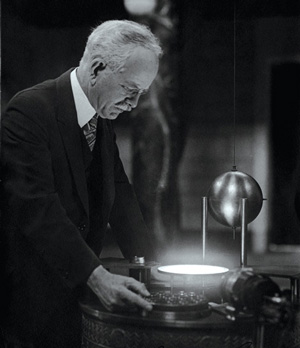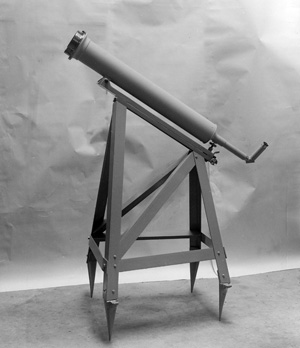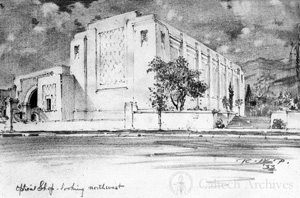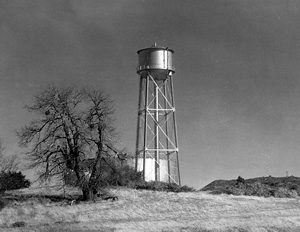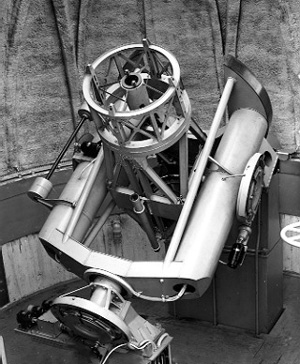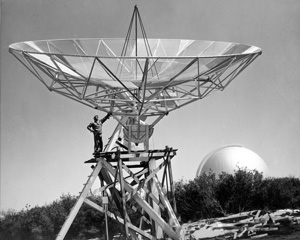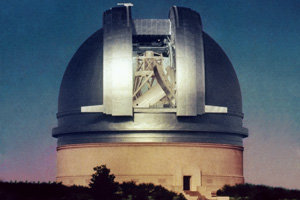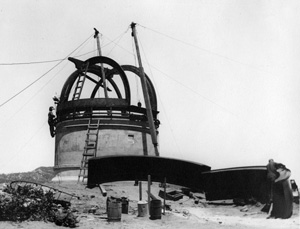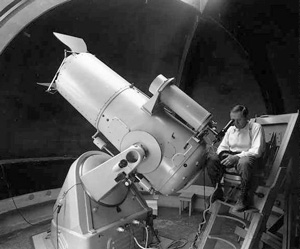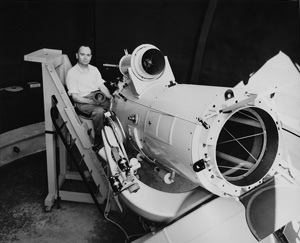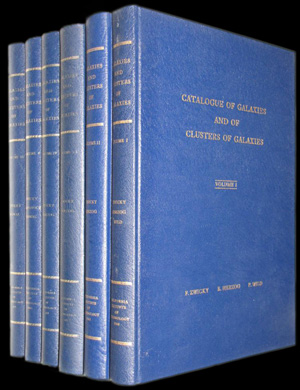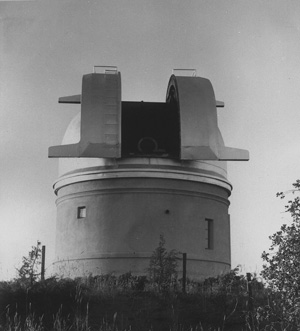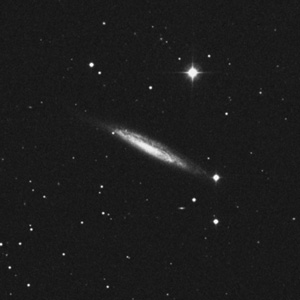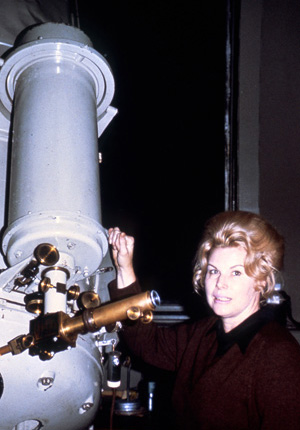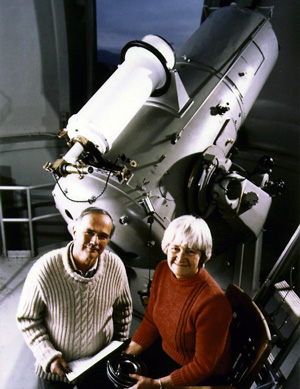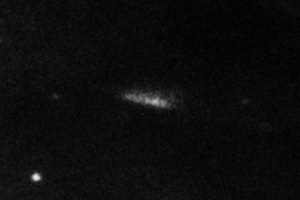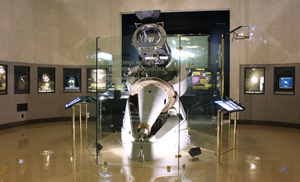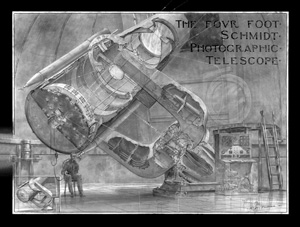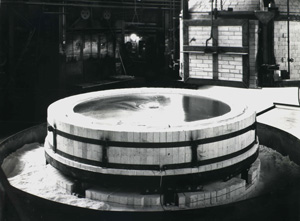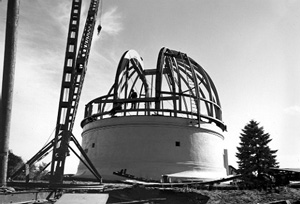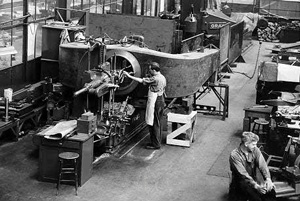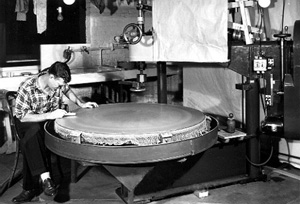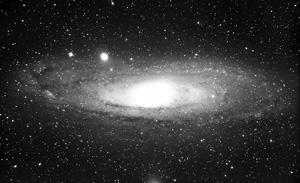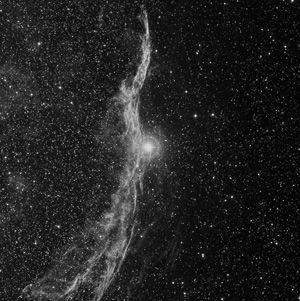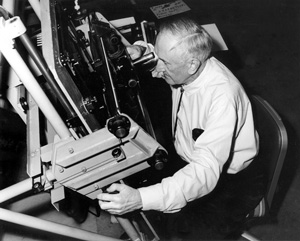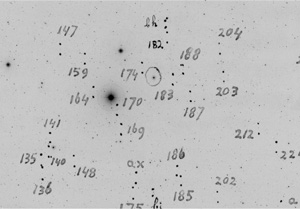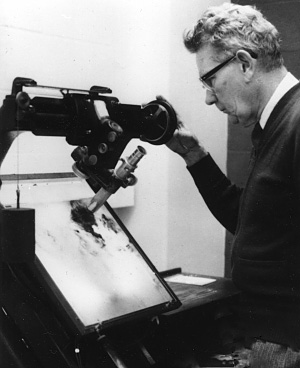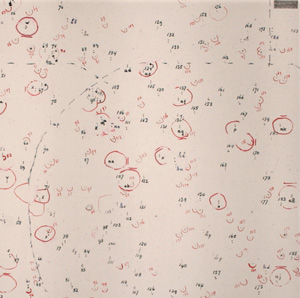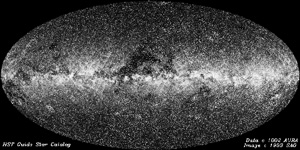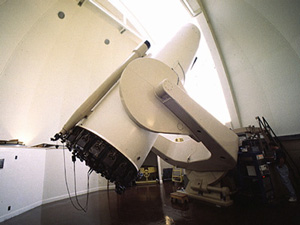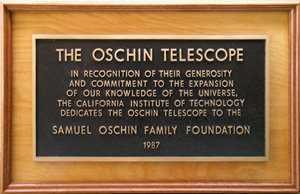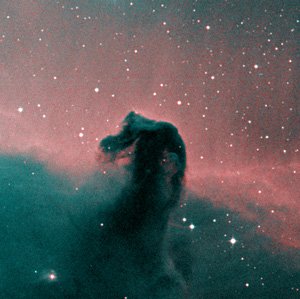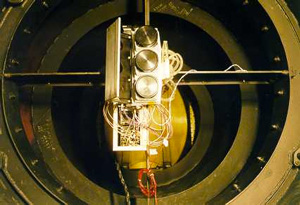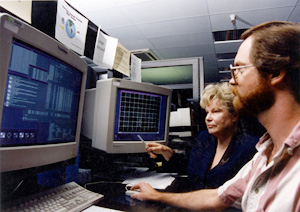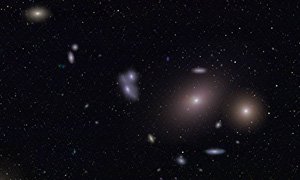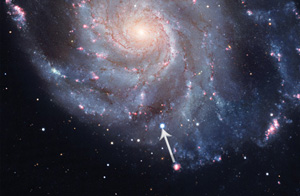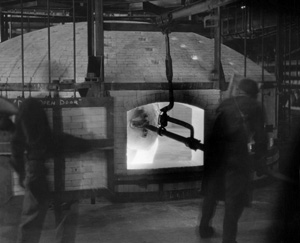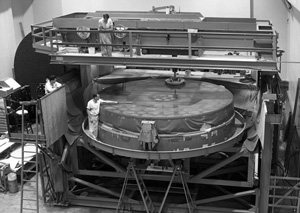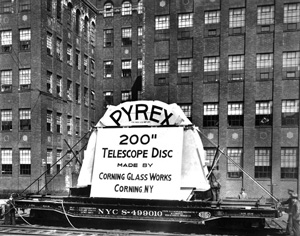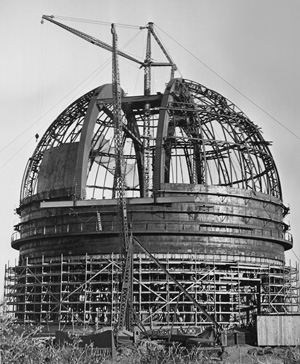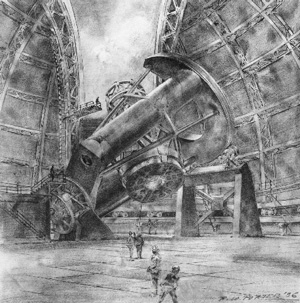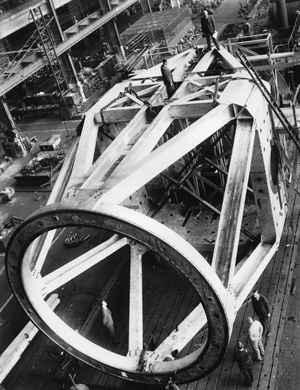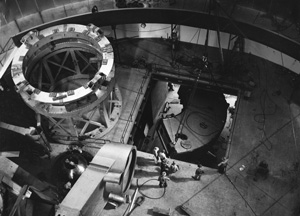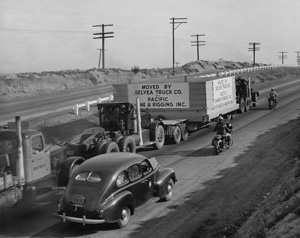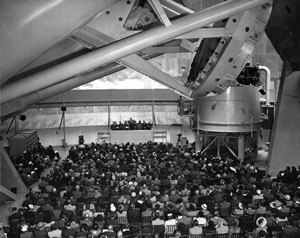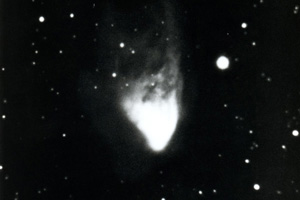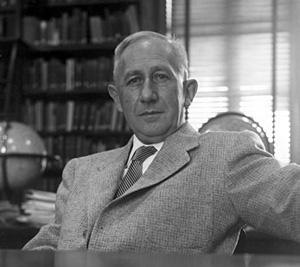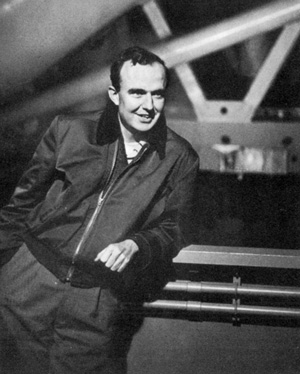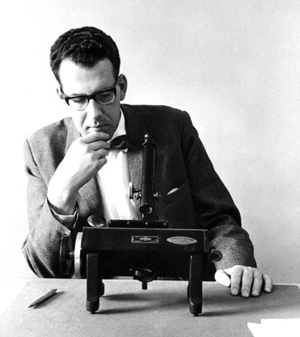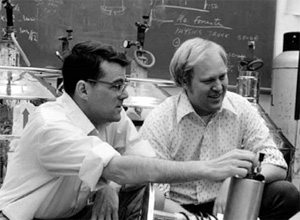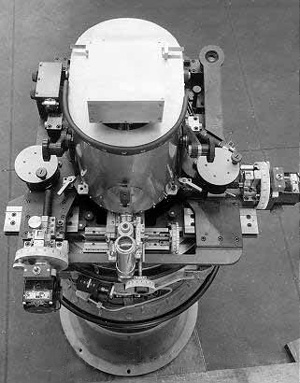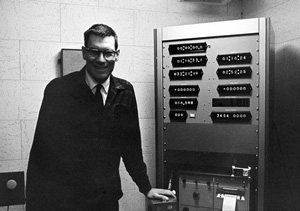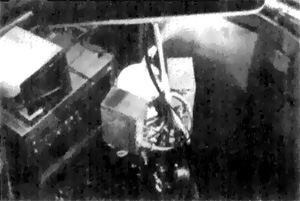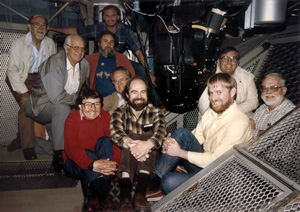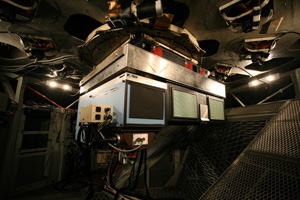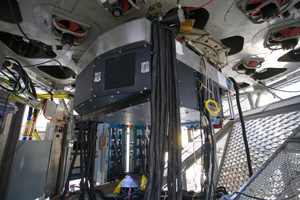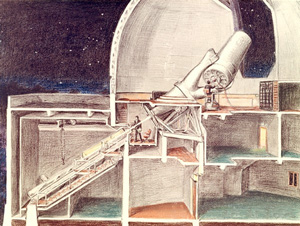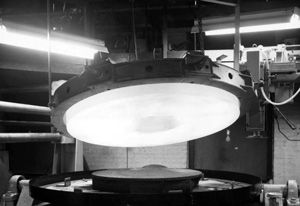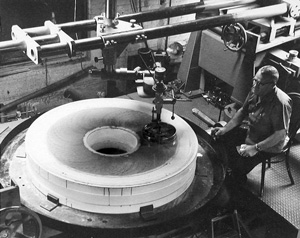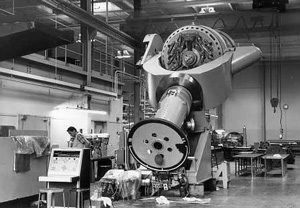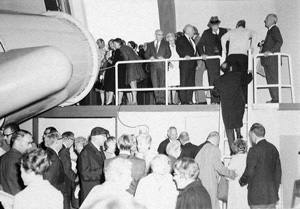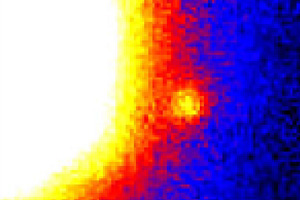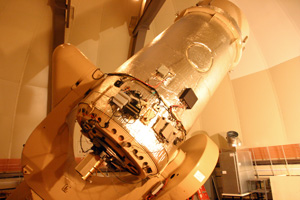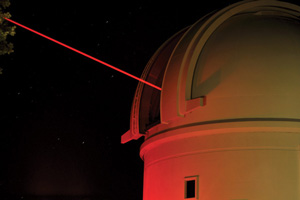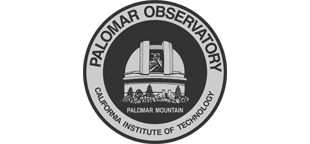
|
|

|
Palomar Observatory Chronology
For narrative and context, please refer to the Palomar history page, as well as the individual pages for the Hale, Samuel Oschin, 60-inch, and 18-inch telescopes.
| General |
| 18-inch |
| 48-inch Oschin |
| 200-inch Hale |
| 60-inch |
Palomar history graphical timeline ( expand). Time starts in 1920 and flows to the right; use the scroll bar to reach the 2010s. Each column corresponds to a decade, vertical lines indicate years. Rows indicate category: general or individual telescopes. Darker background shows when the telescope was operational. Each event is shown as a bar whose width indicates time span. Hovering with mouse over an event will bring up a short explanation. Hint: use the keyboard shortcuts (no shift) control/command + to zoom in, control/command − to zoom out, and control/command 0 to reset. Thumbnails: Palomar/Caltech, Caltech Archives, Corning, Huntington Library, Hubblesite, USGS, PTF, AIP/ESVA.
Notes
General
- Rockefeller grant: awarded June 1928 [es98]
- Site selection: 1929 – 1934 [a42]
- Instrument shop: completed 1931; optical shop: completed 1933 [es48]
- Site work: September 1935 – end of 1938 [a42]
- Hale Telescope 1:10 scale model: conceived and designed 1935, completed 1937 [md35] [es37]
- Radio antenna: installed ca. April 1956, moved to OVRO 1958 [es56] [ai56] [es58] [es94]
- Mt. Wilson and Palomar become the Hale Observatories: 1970 [es48] [es70] [cis]
18-inch Schmidt Telescope
- Dome construction: winter 1935/36 – early summer 1936 [md39]
- Telescope fabrication: 1935 – 1936 [ai36] [z65] [z73] [s04]
- First light: 5 September 1936 [z73]
- Supernova search: September 1936 – January 1942 (interrupted by WWII), resumed ca. May 1954, planned to be continued past 1975 [z59] [w60] [z64] [khs76]
- Clustering of galaxies observations: 1937 – 1942 (interrupted by WWII), 1950 – ca. 1957? [z37] [z38] [z50] [hwz57]
- Nova search: July – October 1950 [hz51] [iaj51] [z64]
- Upgrades: overhauling and partial revision of optics in 1959 for 8 months [hg60]
- Palomar Planet-Crossing Asteroid Survey (PCAS): January 1973 – June 1995 [hs79] [hea97]
- Palomar Asteroid and Comet Survey (PACS): September 1982 – December 1994 [s96]
- Comet Shoemaker-Levy 9: discovered 24 March 1993 [s96]
- On public display: since 22 September 2013; the Helin exhibit was dedicated on 14 June 2014
48-inch Samuel Oschin Telescope
- Planning: ca. May 1937 – 1938 [a42] [f94]
- Dome construction: mostly completed by 1938 [ai38'] [a42]
- Telescope fabrication: 1939 – 1947 (interrupted by WWII) [md39] [a42] [ai46] [ai47]
- Mirror casting: October 1938; shipped to Pasadena a month later [cgw66] [f94]
- Optics work: Mirror ground and polished 1939 – 1940 for 5 months; work on corrector plate interrupted by the war; optics tested on telescope September 1948 [ai48] [o03]
- First official photograph: 29 September 1948 [f94] [s61]
- Operational: 31 January 1949 [z73]
- National Geographic Society – Palomar Observatory Sky Survey (POSS I): 19 July 1949 (intended), 11 November 1949 (actual) – 19 December 1958 [n49] [b51][rd93]
- First deep-sky color images: released April 1959 [es59]
- Palomar Supernova Search: 1958 (preliminary), ca. June 1959 – ca. December 1975 [hg60] [zea63] [z64] [z65'] [z73] [khs76] [k05] [cbat] [psns]
- Palomar – Leiden Faint Minor Planets Survey: 23 September – 25 October 1960 [hea63] [hea84] [ssb07]
- Palomar – Leiden Trojan Surveys: 1971, 19 September – 5 October 1973, 7 – 22 October 1977 [hea89] [hea91] [ssb07]
- Palomar Proper Motion Survey: September 1962 – 1971 [l74]
- Quick V: 1982 – 1984 [lea90]
- Upgrades: new achromatic corrector installed mid-1985; other upgrades (e.g., autoguider, photometer, plate holders, dark rooms) mostly finished by mid-1987 [rea91] [rd93]
- The Second Palomar Observatory Sky Survey (POSS II): mid-1985 – June 2000 [rea91] [rd93] [poss2] [m15]
- Naming/rededication as the Samuel Oschin Telescope: 1987 [es87]
- Near-Earth Asteroid Tracking (NEAT): April 2001 – April 2007; with NEAT camera April 2001 – early 2003, later with QUEST camera [jpl01] [pea01] [hea07] [lea08] [poss2] [neat]
- Palomar-QUEST: July 2003 – September 2008 [s06] [bea09] [sea09] [quest]
- Eris: discovered 5 January 2005 [eris]
- Palomar Transient Factory (PTF): 13 December 2008 (first light), early 2009 – late 2012 [lea14] [ptf]
- intermediate Palomar Transient Factory (iPTF): 13 February 2013 – 2017 (projected) [k13] [iptf]
200-inch Hale Telescope
- Mirror casting: 25 March 1934 (unsuccessful attempt), 2 December 1934 – 25 October 1935 [g36] [cgw66] [f94] [cmog]
- Transport of mirror to Caltech: March 26 – 10 April 1936 [c86]
- Mirror work: May 1936 – October 1947 at the shop, through October 1949 at Palomar [a42] [f94]
- Dome construction: ca. September 1936 – 1939 [md39] [ai38] [a42]
- Telescope design: general specs agreed upon in 1929, detailed design ca. early 1934 – 1936; control system design completed ca. mid-1938 [a42] [f94]
- Telescope construction: 1936 – August 1938; parts began arriving at Palomar 25 October 1938 [pi38] [a42]
- Transport of mirror to Palomar: 18 – 19 November 1947 [r47]
- Dedication of the Observatory and the Hale Telescope: 3 June 1948 [ded48]
- First light: December 1947 [es91]
- First image ("second light"): 26 January 1949 [h49] [es91]
- Operational: 12 November 1949 [s99]
- Images of Moon and planets: December 1952 [es53]
- Optical identification of radio sources: December 1952 (in conjuction with Mt. Wilson) [es53]
- Correction of distance to M31: 1952 [b56]
- New H0 value: 1958 [s58]
- Distance to quasars first determined: early 1963 [es61] [gs64] [s99]
- Galactic center in infrared: September 1966 [bn68]
- Electronic upgrades: 1953 – present [d67] [es98] [wo00] [coopi]
- First photoelectric photometer: ca. 1953 – 1955 [es53'] [es55] [es69]
- First computer system: 1971 [es73]
- Early CCDs: May 1976 – 1979 [gw81] [es82] [gea87]
- Four-shooter: installed 1983, used at least until 1989 [gea84] [gea87'] [pea96]
- Adaptive optics system PALAO: development started summer 1994, operational in December 1999 [dea98] [es99] [mea00] [k05']
- PALM-3000: operational since June 2011 [dea13]
60-inch Telescope
- Planning and design: 1962 – ca. 1966 [ai63] [es66]
- Mirror in shop: ca. February/March 1966 – ca. mid-1969 [hi66] [es70']
- Construction: 1966 – early 1969 [ai69] [es70']
- Computer system development: 1969 – 1970; upgrades ca. 1973 [ai63] [d70] [es73]
- Dedicated: 23 October 1970 [ded70] [hi70]
- Operational: 8 April 1972 [pl72]
- First brown dwarf confirmed: November 1995 [sts95] [es96]
- Automated/robotic: since September 2004 [c06]
- Robo-AO: operational June 2012 – June 2015 [roao]
References [show]
- J. Anderson (May-June 1942) The Astrophysical Observatory of the California Institute of Technology, JRASC, 36:177.
- Caltech Archives 18-inch Schmidt fabrication images.
- Caltech Archives Hale Telescope dome construction images.
- Caltech Archives 48-inch Schmidt dome construction images.
- Caltech Archives 48-inch Schmidt fork fabrication images.
- Caltech Archives 48-inch Schmidt tube fabrication images.
- Caltech Archives 48-inch Schmidt corrector plate images.
- Caltech Archives Antenna images.
- Caltech Archives 60-inch telescope images.
- Caltech Archives 60-inch telescope fabrication image.
- I. Bowen (February 1951) Survey of the Year's Work at the Mount Wilson and Palomar Observatories, PASP, 63:5.
- W. Baade (February 1956) The Period-Luminosity Relation of the Cepheids, PASP, 68:5.
- A. Bauer et al (November 2009) Highly Variable Objects in the Palomar-QUEST Survey: A Blazar Search Using Optical Variability, ApJ, 705:46.
- E. Becklin & G. Neugebauer (January 1968) Infrared Observations of the Galactic Center, ApJ, 151:145.
- D. di Cicco (April 1986) The Journey of the 200-inch Mirror, S&T, 71:347.
- S. Cenko et al (October 2006) The Automated Palomar 60 Inch Telescope, PASP, 118:1396.
- IAU CBAT List of Supernovae.
- Corning Glass Works (1966) Survey of Technical Progress Pt 36: Reflecting Telescope Manufacture—A Résumé of Dr. McCauley's Report "Corning Glass Works and Astronomical Telescopes" (1965, unpublished).
- Carnegie Institution of Science History.
- Corning Museum of Glass The Glass Giant.
- Caltech Optical Observatories Palomar Instruments Twiki.
- E. Dennison (April 1967) Electronics and the New Astronomy, E&S, 30:9.
- E. Dennison (November 1970) Automated Astronomy: Computerization Comes to Palomar, E&S, 34:12.
- R. Dekany et al (September 1998) First Tip-Tilt Correction with the Palomar 200-in. Adaptive Optics System, SPIE, 3353:56.
- R. Dekany et al (October 2013) PALM-3000: Exoplanet Adaptive Optics for the 5 m Hale Telescope, ApJ, 776:130.
- Caltech (3 June 1948) Dedication of the Palomar Observatory and the Hale Telescope.
- Hale Observatories (23 October 1970) Dedication of the Sixty-Inch Telescope and the Oscar G. Mayer Building of the Hale Observatories.
- M. Brown The Discovery of Eris, the Largest Known Dwarf Planet.
- Caltech (September 1937) The Month at Caltech: Scale Model of the 200" Completed, E&S (AR), 1(2):8.
- Caltech (June 1948) Palomar Issue, E&S, 11(6):all.
- Caltech (January 1953) The Moon and the Planets, Radio Astronomy, E&S, 16(4):9.
- Caltech (December 1953) The Month: Success, E&S, 17(3):24.
- Caltech (November 1955) Research Highlights: Astronomy, E&S, 19(2):16.
- Caltech (May 1956) The Month at Caltech: Radio Astronomy, E&S, 19(8):22.
- Caltech (October 1958) Listening to the Stars, E&S, 22(1):17.
- Caltech (April 1959) Color in the Universe, E&S, 22(7):26.
- Caltech (January 1961) The First True Radio Stars, E&S, 24(4):18.
- Caltech (May 1966) Palomar Gets a New Telescope, E&S, 29(8):9.
- Caltech (November 1969) Research Notes: Counting Photons, E&S, 33(2):42.
- Caltech (January 1970) The Month at Caltech: Change of Name, E&S, 33(3):32.
- Caltech (November 1970) A New Telescope at Palomar, E&S, 34(2):10.
- Caltech (January 1973) Electronic Revolution at Palomar, E&S, 36(3):20.
- Caltech (September 1982) Palomar's Future: Too Bright?, E&S, 46(1):18.
- Caltech (Fall 1987) Random Walk: Astronomy Gift, E&S, 51(1):43.
- Caltech (Winter 1991) First Lights, E&S, 54(2):2.
- Caltech (Spring 1994) The Owens Valley Radio Observatory: Early Years, E&S, 57(3):8.
- Caltech (1996) Lab Notes: One Down, Six to Go, E&S, 59(1):39.
- Caltech (1998) Palomar at 50, E&S, 61(3):31.
- Caltech (1999) Random Walk: Caltech Joins Effort to Put Astronomy in Focus, E&S, 62(3):8.
- R. Florence (1994) The Perfect Machine, HarperPerennial, 121–125, 240–242, 281, 286–291, 312, 340, 367, 397–398, 430.
- O. Gage (June 1936) The 200-inch Telescope Eye, JRASC, 30:169.
- J. Gunn et al (March 1984) A Large-Format, High-Efficiency CCD Camera for the Hale Telescope, BAAS, 16:477.
- J. Gunn, E. Emory, F. Harris, & B. Oke (June 1987) The Palomar Observatory CCD Camera, PASP, 99:518.
- J. Gunn et al (August 1987) Four-Shooter: A Large Format Charge-Coupled-Device Camera for the Hale Telescope, OptEn, 26:779.
- J. Greenstein & M. Schmidt (July 1964) The Quasi-stellar Radio Sources 3C 48 and 3C 273, ApJ, 140:1.
- J. Gunn & J. Westphal (January 1981) Care, Feeding, And Use Of Charge-Coupled Device (CCD) Imagers at Palomar Observatory, SPIE, 290:16.
- E. Hoge (May 1949) The 200-inch Telescope Takes Its First Pictures, E&S, 12(8):3.
- C. van Houten, I. van Houten-Groeneveld, P. Herget, & T. Gehrels (October 1970) The Palomar–Leiden Survey of Faint Minor Planets, A&AS, 2:339.
- I. van Houten-Groeneveld, C. van Houten, M. Wisse-Schouten, C. Bardwell, & T. Gehrels (October 1989) The 1977 Palomar–Leiden Trojan Survey, A&A, 224:299.
- C. van Houten, P. Herget, & B. Marsden (July 1984) The Palomar-Leiden Survey of Faint Minor Planets: Conclusion, Icarus, 59:1.
- C. van Houten, I. van Houten-Groeneveld, M. Wisse-Schouten, C. Bardwell, D. Green, & T. Gehrels (June 1991) The Second Palomar-Leiden Trojan Survey, Icarus, 91:326.
- E. Helin, S. Pravdo, D. Rabinowitz, & K. Lawrence (May 1997) Near-Earth Asteroid Tracking (NEAT) Program, NYASA, 822:6.
- M. Hicks, R. Bambery, K. Lawrence, & P. Kollipara (June 2007) Near-Nucleus Photometry of Comets Using Archived NEAT Data, Icarus, 188:457.
- M. Humason & H. Gates (June 1960) The 1959 Palomar Supernova Search, PASP, 72:208.
- Huntington Library 60-inch mirror blank images.
- Huntington Library Dedication of the 60-inch telescope images.
- E. Helin & E. Shoemaker (December 1979) The Palomar Planet-Crossing Asteroid Survey, 1973-1978, Icarus, 40:321.
- E. Herzog, P. Wild, & F. Zwicky (October 1957) A New Catalogue of Bright Galaxies and Clusters of Galaxies, PASP, 69:409.
- E. Herzog & F. Zwicky (June 1951) The Palomar Search for Novae and the Light-Curves of Three Novae of 1950 in Scorpius, PASP, 63:121.
- IrAJ (December 1951) News and Comments: A Systematic Search for Novae, IrAJ, 1:240.
- iPTF Collaboration website.
- JPL (April 2001) NASA to Track More Asteroids with New NEAT Camera, press release.
- T. Koenig (December 2005) Fritz Zwicky: Novae Become Supernovae, ASPC, 342:53.
- S. Kardel (2005) Untwinkle, Untwinkle, Laser Star, E&S, 68(3):8.
- S. Kulkarni (February 2013) The Intermediate Palomar Transient Factory (iPTF) Begins, ATel #4807.
- C. Kowal, J. Huchra, & W. Sargent (August 1976) The 1975 Palomar Supernova Search, PASP, 88:521.
- B. Lasker, C. Sturch, B. McLean, J. Russell, H. Jenkner, & M. Shara, (June 1990) The Guide Star Catalog. I – Astronomical Foundations and Image Processing, AJ, 99:2019.
- K. Lawrence et al (September 2008) Preliminary Photometric Results Obtained from the NEAT Archive, DPS, 40:2809.
- R. Laher et al (July 2014) IPAC Image Processing and Data Archiving for the Palomar Transient Factory, PASP, 126:674.
- W. Luyten (1974) The Palomar Proper Motion Survey, IAUS, 61:169.
- C.S. McDowell (September 1935) Progress Memorandum, Caltech Archives.
- C.S. McDowell (January 1939) Final Report on the 200-inch Telescope Project, Caltech Archives.
- J.E. Mueller (July 2015) private communication.
- T. Mitchell et al (July 2000) Palomar Adaptive Optics Project: Status and Performance, SPIE, 4007:31.
- Nature (July 1949) News: Sky Survey by the Schmidt Telescope at Palomar, Nature, 164:97.
- NEAT on the web: JPL's NEO, PDS archive, old NEAT website.
- D. Osterbrock (June 2003) Don Hendrix, Master Mount Wilson and Palomar Observatories Optician, JAHH, 6:1.
- S. Pravdo, E. Helin, M. Hicks, & K. Lawrence (November 2001) Near-Earth Asteroid Tracking at Palomar and Maui, DPS, 33:5901.
- M. Postman et al (February 1996) The Palomar Distant Clusters Survey. I. The Cluster Catalog, AJ, 111:615.
- Palomar Observatory/Froebel Collection, Westinghouse images.
- Palomar Observatory, 60-inch telescope first logbook.
- W. Sargent The Second Palomar Observatory Sky Survey (POSS II).
- ADS All Palomar Supernova Search papers.
- PTF Collaboration website.
- QUEST on the web: The Palomar-QUEST Sky Survey, The QUEST Camera
- R. Richardson (December 1947) The 200-inch Mirror Goes to Palomar Mountain, PASP, 59:310.
- I. Reid et al (July 1991) The Second Palomar Sky Survey, PASP, 103:661.
- I. Reid & G. Djorgovski (January 1993) The Second Palomar Sky Survey, ASPC, 43:125.
- Robo-AO Collaboration website.
- A. Sandage (May 1958) Current Problems in the Extragalactic Distance Scale, ApJ, 127:513.
- A. Sandage (1961) The Hubble Atlas of Galaxies, Carnegie Institution of Washington, 18.
- C. Shoemaker (February 1996) Twelve Years on the Palomar 18-inch Schmidt, JRASC, 90:18.
- A. Sandage (September 1999) The First 50 Years at Palomar (1949–1999). The Early Years of Stellar Evolution, Cosmology, and High-Energy Astrophysics, ARA&A, 37:445. See also same content as a website.
- A. Sandage (2004) Centennial History of the Carnegie Institution of Washington: Volume 1, 387.
- D. Smith (November 2006) Picture This, E&S, 69(4):20.
- R. Scalzo p. Nugent, C. Baltay, G. Djorgovski, Palomar-Quest Survey Team, & DeepSky Collaboration (January 2009) The Palomar/QUEST-DeepSky RG-610 Variability Survey, BAAS, 41:258.
- L. Schmadel, R. Stoss, & G. Burkhardt (October 2007) Digitization of the Palomar–Leiden Survey and Trojan Survey Plates, ASPC, 377:294.
- STScI (29 November 1995) Astronomers Announce First Clear Evidence of a Brown Dwarf.
- P. Wild (April 1960) Lightcurves of the Supernovae of 1954, PASP, 72:97.
- G. Wallerstein & B. Oke (September 2000) The First 50 Years at Palomar (1949–1999). Another View: Instruments, Spectroscopy and Spectrophotometry, and the Infrared, ARA&A, 38:79.
- F. Zwicky (May 1937) On a New Cluster of Nebulae in Pisces, PNAS, 23:251.
- F. Zwicky (August 1938) On the Clustering of Nebulae, PASP, 50:218.
- F. Zwicky (October 1950) The Cancer Cluster of Galaxies PASP, 62:196.
- F. Zwicky (November 1959) Search for Supernovae E&S, 23(2):24 .
- F. Zwicky (February 1964) Basic Results of the International Search for Supernovae, AnAp, 27:300.
- F. Zwicky (1965) The Early History of the Faint Blue Star Program, First Conference on Faint Blue Stars (Aug 1964), 3.
- F. Zwicky (December 1965) The 1964 Palomar Supernova Search, PASP, 77:456.
- F. Zwicky (May 1973) 100 Supernovae—The Reward of a 40-Year Search, E&S, 36(6):20.
- F. Zwicky, J. Berger, H. S. Gates, & K. Rudnicki (June 1963) The 1962 Palomar Supernova Search, PASP, 75:236.
Questions? We've answered many common visiting, media, and academic questions in our public FAQ page.
Please share your feedback on this page at the
COO Feedback portal.
Chronology / v 1.0.5
Last updated: 28 April 2024 ACM
|
|
|
